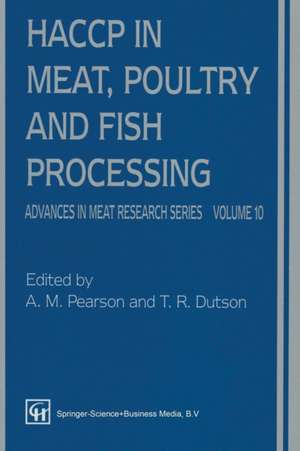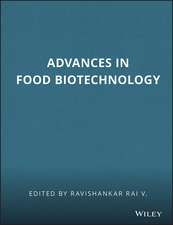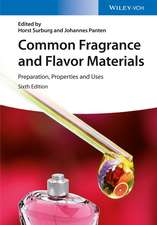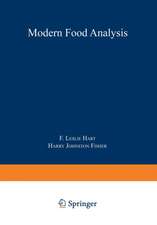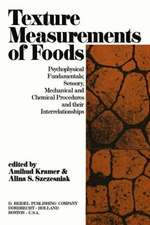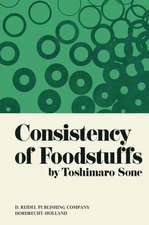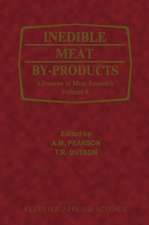HACCP in Meat, Poultry, and Fish Processing: Advances in Meat Research, cartea 10
Autor A. M. Pearson, T. R. Dutsonen Limba Engleză Paperback – 11 mar 2013
Preț: 589.65 lei
Preț vechi: 693.70 lei
-15% Nou
Puncte Express: 884
Preț estimativ în valută:
112.87€ • 122.64$ • 94.87£
112.87€ • 122.64$ • 94.87£
Carte tipărită la comandă
Livrare economică 21 aprilie-05 mai
Preluare comenzi: 021 569.72.76
Specificații
ISBN-13: 9781461358985
ISBN-10: 1461358981
Pagini: 412
Ilustrații: XV, 393 p.
Dimensiuni: 155 x 235 x 22 mm
Greutate: 0.58 kg
Ediția:Softcover reprint of the original 1st ed. 1995
Editura: Springer Us
Colecția Springer
Seria Advances in Meat Research
Locul publicării:New York, NY, United States
ISBN-10: 1461358981
Pagini: 412
Ilustrații: XV, 393 p.
Dimensiuni: 155 x 235 x 22 mm
Greutate: 0.58 kg
Ediția:Softcover reprint of the original 1st ed. 1995
Editura: Springer Us
Colecția Springer
Seria Advances in Meat Research
Locul publicării:New York, NY, United States
Public țintă
ResearchCuprins
1 The origin and concept of HACCP.- 1.1 Introduction.- 1.2 Development of the HACCP concept.- 1.3 Acceptance of HACCP by the food industry.- 1.4 Summary.- References.- 2 The HACCP system and how it fits into FSIS programs.- 2.1 Introduction.- 2.2 HACCP study.- 2.3 Critical control points for various models.- 2.4 In-plant testing of HACCP models.- 2.5 Evaluation.- 2.6 Current HACCP issues.- 2.7 Quadrilateral discussions on food safety.- 2.8 Summary.- References.- 3 Implementation of HACCP program on farms and ranches.- 3.1 Introduction.- 3.2 Livestock quality assurance programs.- 3.3 Implementing HACCP on livestock units.- 3.4 Conclusion.- References.- 4 Implementation of the HACCP program by meat and poultry slaughterers.- 4.1 Introduction.- 4.2 Purpose of HACCP.- 4.3 Development of the HACCP program.- 4.4 Implementation of the HACCP program.- 4.5 Summary.- References.- 5 The use of HACCP for producing and distributing processed meat and poultry products.- 5.1 Introduction.- 5.2 Reasons for using HACCP.- 5.3 Developing HACCP plans.- 5.4 Hazard analysis and risk assessment.- 5.5 Critical control points and critical limits.- 5.6 Monitoring.- 5.7 Corrective action.- 5.8 Record keeping.- 5.9 Verification.- 5.10 Should HACCP be mandatory?.- 5.11 Summary.- References.- Addendum — Guideline for writing operating instructions/HACCP plans for processed meat and poultry products.- 6 Implementation of the HACCP program by the fresh and processed seafood industry.- 6.1 Introduction.- 6.2 Significance of the seafood industry.- 6.3 HACCP in the seafood industry.- 6.4 HACCP and seafood safety.- 6.6 NMFS HACCP program.- 6.7 FDA’s HACCP program.- 6.8 Impact of FDA’s proposed HACCP regulation — an example.- 6.9 Summary.- References.- 7 Risk analysis, HACCP and microbial criteriain meat and poultry systems.- 7.1 Introduction.- 7.2 Risk analysis.- 7.3 How risk analysis and HACCP contribute to food safety.- 7.5 The role of microbiological criteria.- 7.6 Statistical process control.- 7.7 Summary.- Acknowledgements.- References.- 8 Relationship of the HACCP system to Total Quality Management.- 8.1 The importance of quality.- 8.2 Total Quality Management (TQM): the key to continuous quality improvement.- 8.3 The Hazard Analysis Critical Control Point (HACCP) system.- 8.4 Modern quality management: striving for continuous quality improvement.- 8.5 The economics of quality.- 8.6 Implementation of TQM and HACCP.- 8.7 ISO 9000.- 8.8 The National Quality Award.- 8.9 Summary.- Acknowledgements.- References.- 9 HACCP for delicatessens and meat, poultry and seafood retailers.- 9.1 Introduction.- 9.2 Potential hazards.- 9.3 Hazard controls.- 9.4 Monitoring.- 9.5 Corrective actions.- 9.6 Records.- 9.7 Verification.- 9.8 A deli HACCP plan.- 9.9 Example HACCP plans.- 9.10 Summary.- References.- 10 HACCP-TQM for retail and food service operations.- 10.1 Introduction.- 10.2 What is quality?.- 10.3 HACCP principles for food production.- 10.4 Food science HACCP principles.- 10.5 The HACCP-based TQM process.- 10.6 Food operations hazard analysis.- 10.7 Summary.- References.- 11 The HACCP program and the consumer.- 11.1 Introduction.- 11.2 The HACCP program.- 11.3 HACCP and consumers.- 11.4 HACCP incorporation into everyday life.- 11.5 Application of HACCP principles for consumers.- 11.6 Conclusions.- References.- 12 Organization and management of HACCP programs.- 12.1 Introduction.- 12.2 Documentation of HACCP systems.- 12.3 Phases of HACCP system implementation and management requirements.- 12.4 Producing the framework/structure to ensure that the HACCP program isa success.- 12.5 Summary.- References.- 13 Predictive microbiology and HACCP.- 13.1 Introduction.- 13.2 Predictive microbiology.- 13.3 Predictive modelling and and HACCP.- 13.4 Examples of the application of predictive models in HACCP systems.- 13.5 Conclusions.- References.- 14 National and international cooperation on governmental regulations for meat, poultry and fish inspection.- 14.1 Overview.- 14.2 Agencies and functions.- 14.3 Domestic interests and cooperation.- 14.4 International interests and cooperation.- 14.5 Opportunities to increase cooperation.- 14.6 Summary.- References.
